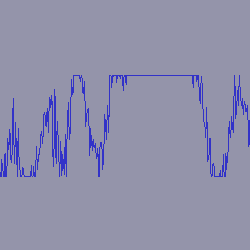Audio mastering
| Note: Some information in this article may be bassless. Don't let this treble you. |
Audio mastering is the process of preparing recorded audio for production, and often involves extensive signal processing. This processing can be either analog or digital in nature, digital processing largely having superseded analog processing since the 1990s. There are many important techniques used for the improvement of professional recordings, making use of processing such as compression, limiting, saturation, equalization, and - most importantly - muting.
History[edit | edit source]
Early musical performances were often recorded with only one microphone, and were cut directly onto a acetate, which was much like a vinyl record, except much more inflammable and exclusive. The song was literally cut into the soft surface of the rotating acetate blank with a needle in one take, while the artists performed in front of a microphone. This meant that actual, talented musicians were necessary to produce the recording. As this greatly limited the potential for music production, early attempts at automating the process were made, including the use of self-cutting emo acetates. However, these attempts were short-lived, due to the blood-loss stemming from unsafe handling of the cutting-edge of technology. Instead, mass produced vinyl records were subsequently made for playback from acetate recordings, and much profit was made.
With the advent of magnetic tape another step and player in the process was added - the mastering process and the mastering engineer. The sounds captured on the analog tape medium had to be transferred onto a spinning record-disc, which apart from being made by a different material, probably metal, was like an acetate. A master could be created from this, from which the aforementioned mass production could then proceed.
One of the tasks these technicians handled was to limit the level and frequency range of the original recording, so that the music produced wouldn't cause the needle to jump out of it's groove during the playing of the record, as that would be far from groovy. As the excessive vibrations from which the problem stemmed were typically of lower frequencies, these came to be basslessly discriminated against in the UK for years until angry British musicians demanding the ability to use sounds like those used in Detroit, USA - where the low frequencies were slowly clawing their way up to musical and financial success - stirred up enough treble.
It was during this time period that secretive and very conservative figures developed their mysterious art. Primitive but still desirable machines were developed to help these recording and mastering engineers, such as the LA-2A, of which several still exist. The LA-2A and other devices used something called Vacuum Tubes or Valves, which were electrified glass bottles that glowed reassuringly and generated heat which helped warm up the sound, and provide the fuzzy saturation so strongly desired even today.
After decades of unchallenged rule, these mastering engineers had settled into an exclusive oligarchy that would remain unchallenged well into the 21st century. Ruled by a man known only as Ludwig, these mastering engineers still guard the last step of the recording process and its secrets from the general public, not to mention their arch enemies, the artists and recording engineers.
Analog Warmth[edit | edit source]
The achievement of proper analog warmth through the careful use of processing such as saturation is a fundamental requirement for the production of good mixes and masters. Traditionally, vintage gear such as tube amplifiers and toasters has been used to achieve that highly acclaimed, warm and fuzzy sound, but as advances have been made within the field of Digital Signal Processing, the use of sophisticated digital tools emulating the characteristics of low-fi analog equipment have largely come to take their place.
Using The Right Amount of Saturation[edit | edit source]
As everyone knows, might is right, so it naturally follows that the right amount of saturation equals a mighty clipping. This has the additional advantage of freeing up extra headroom, allowing for the further increasing of the RMS level of the signal in the sacred quest for loudness maximization. This can be best expressed with Lemmy's Law: "Everything Louder Than Everything Else". Some may object to this, insisting that truncating the waveform adds harsh distortion and thus ruins the sound, but they clearly do not know what they are talking about. Just study the waveform of any modern master, and you'll see the fine results stemming from the careful use of delicately applied, raw and unadorned chopping.
Additionally, if you are not satisfied with mere clipping, you can use even more sophisticated ways of altering the waveshape, such as the wrapping caused by integer overflow.
Loudness Maximization[edit | edit source]
Loudness maximization is the process of carefully compressing, limiting, and clipping the signal to death, freeing up additional headroom in order to allow for the perceived signal level to be increased. During the last few decades, the lengths this practice has gone to have been increasing steadily, and in a couple of years, most new masters are predicted to feature audio having waveforms similar to that of the audio captured in the image to the right. It is hoped that this will obsolete the fine, delicate compression currently used in radio broadcasts by making everything the same level in the original recording.
Some audiophiles have been complaining about supposedly hearable distortion and listening fatigue, but seeing as the vast majority of listeners are fully content with today's music recordings and do not mind having their ears fed with a wall of noise, they are dismissed - and righfully so - by the true experts, the recording labels instructing their reluctant engineers to perform this kind of processing.

